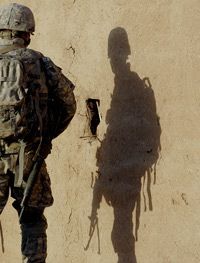The British Ministry of Defence captured the attention of the global media in October 2007, when it announced that it had successfully made a tank invisible to the human eye. Although the British government is keeping the details to itself, it released the basic idea behind the technology.
The tank is coated in silicon, effectively turning the vehicle into a highly reflective movie screen. Video cameras positioned on the tank take real-time footage of the surrounding environment, and projectors show the images on the surface of the tank. To observers at secret trials conducted by the British army in October 2007, the only thing visible was the images of the terrain projected onto the tank.
Advertisement
The British military plans on having the tanks battlefield-ready by 2012, but this technique may be short-lived due to some drawbacks. Cameras or projectors may fail, and from different angles, the tank may be visible. It's a somewhat clumsy and difficult way of rendering an object invisible (HowStuffWorks discussed this technology in another article on invisibility cloaks). Using cameras and projectors creates a smoke-and-mirrors style optical illusion, and the lead researcher at the British test isn't entirely satisfied with the technology.
"The next stage is to make the tank invisible without [cameras and projectors]," physicist Sir John Pendry tells the Daily Mail, "which is intricate and complicated, but possible."
In addition to Pendry, universities around the world and the United States military are exploring the possibilities of actually making an object invisible using next-generation cloaking technology that actually manipulates light. The U.S. Defense Advanced Research Projects Agency (DARPA) -- the research wing of the Pentagon -- has received the green light for $15 million in funding over three years to investigate urban obfuscants. This ambitious project is an attempt to create a protective shield for use by soldiers in urban combat situations. A shield that opens quickly in tight spaces and protects a soldier from enemy fire would be a great asset, but DARPA's not stopping there. This shield would also be able to make the soldier beneath it invisible, and would be self-healing, meaning that if a bullet does manage to get through the shield, the material could repair itself.
Chances are, DARPA will be successful in its quest -- eventually. The physics are already in place to make it possible, and when the technology to create the necessary parts becomes available in the next decade, these cloaking devices will leave the realm of science fiction and enter reality.
But how is this possible? How can we manipulate light? It's all based on some very small particles. Read the next page about metamaterials.
Advertisement


